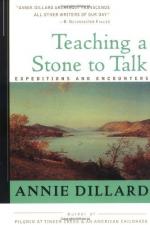|
This section contains 381 words (approx. 1 page at 400 words per page) |

|
Teaching a Stone to Talk Summary & Study Guide Description
Teaching a Stone to Talk Summary & Study Guide includes comprehensive information and analysis to help you understand the book. This study guide contains the following sections:
This detailed literature summary also contains Topics for Discussion on Teaching a Stone to Talk by Annie Dillard.
In Teaching a Stone to Talk: Expeditions and Encounters, Annie Dillard shares fourteen separate personal essays with the reader. Each essay is a distinct and independent recounting of an event or place that Annie has encountered in her life. The settings include the jungle in Ecuador, the Galapagos Islands, a church service, and a cottage in the Appalachian Mountains among others. Weaving through her narrative of the events and places are common themes of spirituality, exploration, and discovery.
Annie ponders spiritual and religious questions and meaning in a number of the essays. In "An Expedition to the Pole", she weaves in her experiences at Mass with the history of polar explorers, realizing that everyone is searching for the sublime with their actions and balancing it with their humanity. In "The Deer at Providencia", Annie questions suffering on earth and why it happens. She also argues in the essays that what people do on earth does not change God, but it changes the people themselves. "Teaching a Stone to Talk", " A Field of Silence", and "God in the Doorway" also address religious and spiritual questions and themes.
Annie also uses several essayS to highlight the idea of exploration. She discusses some of the places that she has visited, including The Galapagos Islands and the Napo River in Ecuador. In addition, she brings in historical information about polar explorers and Darwin's travels to the Galapagos in "An Expedition to the Pole" and "Life on the Rocks: The Galapagos", respectively. Annie argues in several of the essays that people have been placed on earth to watch and observe. Exploration of one's surroundings and the world become a part of this watching, as one only has a lifetime to see what the earth holds and learn from it.
Finally, a number of the essays discuss the idea of discovery. Heavily tied to the previous two themes, the discussion of discovery is about how people examine and see the world. Discovery is all around if people only open their eyes to it. "Living Like Weasels", "On a Hill Far Away", "Lenses", "Total Eclipse", and "Mirages" all discuss finding something extraordinary in the events, people, and places around where people live. Annie finds discovery on walks from her home and through a microscope.
Read more from the Study Guide
|
This section contains 381 words (approx. 1 page at 400 words per page) |

|



